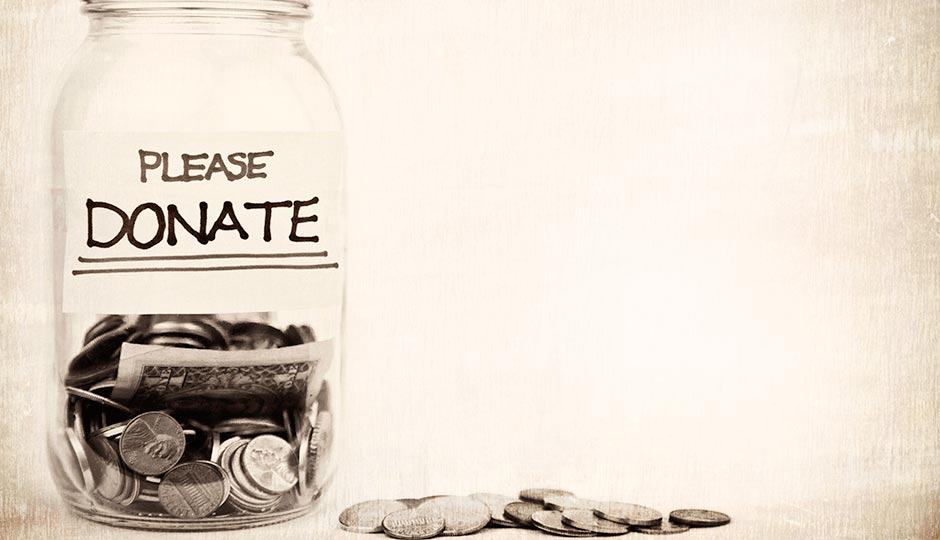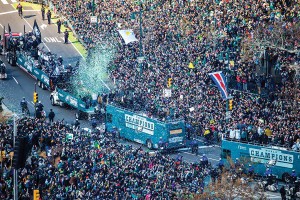Only You Can Fix Philly’s Philanthropy Crisis
Foundations have left. Religious giving is in the tank. We’re now, somehow, among the least generous metros in America. Philadelphia, it’s time to step up.

Photograph courtesy of iStock
On a Monday morning in October, in the soft-hued glow of a public-radio-station studio, a former private equity investor is making a convincing case for the existence of zombies. The man at the lectern, John MacIntosh, partner at NYC-based SeaChange Capital Partners, throws lots of scary numbers at the crowd of more than 100 — a who’s who of the local nonprofit and charity world — but nothing quite so ghastly as his eventual prophecy about the undead.
“Many of the not-for-profits in New York that have struggled, they’ve ended up being what I’ll call ‘zombies,’” MacIntosh tells the audience at WHYY. “They’ve become so weak, they use all their energy to keep the lights on. The capacity to innovate is gone, and perhaps gone forever.”
It’s a cautionary tale for Philly nonprofits, some of which, MacIntosh suggests, might be zombifying as well. He’s a featured speaker at a gathering convened by the Philadelphia Foundation, the nearly 100-year-old organization — one of the country’s oldest “community foundations” — that wears many hats in the five-county region: as a connector, a funder, and a think tank for local charity.
The WHYY event is keyed to the release of a Philadelphia Foundation-funded report titled The Financial Health of Philadelphia-Area Nonprofits, and — I’ll save you the full read — the sector’s outlook is less than rosy. Of the 3,200 area nonprofits analyzed (a sample that includes those big enough to file IRS 990 reports, but excluding the region’s largest eds and meds), more than 40 percent had a zero or negative operating margin over the past three years. One in five has less than a month of cash reserves on hand. And those numbers are taken from IRS data from 2014, prior to the state budget boondoggles in Harrisburg that have further squeezed funds. “I would argue that most of these [40 percent] are so busy scrambling to keep the lights on, it’s hard enough for them to deliver good programming on a day-in, day-out basis, let alone survive the inevitable shock of what will come down the pike,” says MacIntosh.
The data — the first comprehensive look at the region’s sector after the Great Recession — confirmed a lot of what leaders in the space already know: Giving isn’t what it used to be in Philly. In the past couple of decades, some of the region’s funding stalwarts have scaled back or left town. Giving on an individual basis is flat at best and has potentially dropped since 2006, depending on which IRS info you look at. Meanwhile, the number of local nonprofits has exploded. Between 1995 and 2008, the arts-and-culture space alone grew by more than 1,000 organizations here — a 64 percent increase. In Philadelphia, there’s now one nonprofit for every 200 residents, putting us in the top 30 counties nationwide in nonprofit concentration, far ahead of the likes of King County (home of Seattle) and Cook County (Chicago) — regions that boast significantly higher rates of giving.
Indicators suggest the local nonprofit sector has entered a zero-sum game. To get ahead of the coming challenges, in 2015 a team of nine funders, including the region’s largest funder, the William Penn Foundation, launched the Greater Philadelphia Nonprofit Repositioning Fund. The fund’s mission is to support partnerships and collaborations among nonprofits to foster financial sustainability in the region. Getting there will necessitate difficult conversations, including the possibility of responsible mergers between organizations. “It’s never been harder for nonprofits to fund-raise,” says Nadya Shmavonian, director of the fund. “There’s been a proliferation of nonprofits at a time when there’s simply not enough funding to go around. We hope to strengthen nonprofits’ ability to deliver their services through wise collaboration.”
How is it that Philly — a city with deep Quaker roots and a nickname that practically drips with generosity — is home to a philanthropic sector that appears very much on the brink?
Last spring, President Donald Trump was grumbling about his displeasure with Philly and other “sanctuary cities” and making constitutionally dubious threats to withdraw federal funding. With at least $400 million hanging in the balance for the public sector, including vital public health grants used to fight the opioid epidemic, trumpets began to blare in the Philly nonprofit world. “I was padding around the house on a Sunday in my bunny slippers, and I took my phone out of my pajamas and asked Siri, ‘Individual philanthropic giving in Philadelphia compared to other cities,’” recalls Don Kligerman, founder of Fairmount Ventures, a Philly-based consulting firm serving the nonprofit, public and philanthropic sectors.
If federal funding were withdrawn, Kligerman wanted to know, could the region make up that money in the nonprofit arena? “We suck,” Kligerman recalls concluding almost immediately, based on Siri’s search. He later wrote a blog post delivering a call to action.
In that post, he made the point that of the major metropolitan areas in the country, Philly ranks remarkably low in dishing out tax-deductible donations. Per a new Chronicle of Philanthropy report, we’re 43rd out of America’s 50 biggest cities. The people of Memphis give more than twice as much to charitable causes: 5.6 percent of their income compared to our 2.5 percent. Baltimore, another city with a glaring poverty problem, is significantly more generous than we are. The Chronicle of Philanthropy calculates our “giving opportunity” — the additional amount we’d raise if we simply gave at the national average — at a whopping $966 million.
Not that all of the money would go to local causes, but some certainly would. It’s a generosity gap that’s hurting a nonprofit sector — some members of which, such as African-American-led nonprofits, are hurting more than others — that’s responsible for one in eight of the region’s jobs, according to a 2010 Philadelphia Foundation report. And we depend on the nonprofit sector for jobs more than most cities — at nearly double the rate of New York.
Where did things go wrong? While many economists, including the Economist, saw a golden age of philanthropy dawning in the late 1990s and early 2000s — buoyed by the new wealth of the dot-com boom, a soaring stock market, and post-9/11 groundswells in donations — Philly was bracing for a murky transition. The Annenberg Foundation, following the deaths of namesake Walter and his wife Leonore (and the distribution of billions of dollars to local causes since its establishment in 1989), relocated to Los Angeles. Meanwhile, the Pew Charitable Trusts were undergoing a radical reorganization. In 2004, Pew moved the majority of its workforce to Washington, D.C., as it evolved into a global force in research and advocacy as much as a charitable behemoth. While Pew remains one of our top local funders — including Center City’s Pew Center for Arts & Heritage, which retains an outsize impact on the local arts scene — the sense that Philly is the foundation’s favorite child has worn off. Annenberg’s departure, coupled with the new-look Pew, left a dearth of large institutional donors in the region. And aside from William Penn, nobody has swooped to the rescue.
The loss of Annenberg was only one gut punch. Broader societal trends also put a damper on the giving culture in Philly. Religious donations, for instance, faltered. Philly, like most places hit by Catholic Church scandals, has seen a drop in gifts to religious groups as a result, according to a 2015 study.
Of greater long-term consequence has been the impact of white flight and concentrated poverty. The Philly metro area is one of the country’s most glaring examples of economic segregation, which, scholars have concluded, affects donations in profound ways. As a general rule, rich enclaves invest less money in nonprofits and charities than rich individuals living within economically diverse areas, according to several different studies.
This holds true in our five-county region, where the suburbs are relatively stingy. Take Bucks County, with a giving rate of only 1.9 percent of its income, according to the Chronicle of Philanthropy. If all the income brackets in Bucks simply gave the Pennsylvania average (2.6 percent), there’d be another $119 million for philanthropy every year. Hell, if only one income bracket, the people making between $100,000 and $200,000, gave the state average, there would be $27 million more per year. Imagine if that went to Philadelphia-area nonprofits. It would be more money than the Philadelphia Foundation gave out last year.
According to many nonprofit leaders I spoke with, what’s hampering charitable investment in Philly isn’t an absence of wealth so much as a cultural handicap. It could be that Quaker modesty still lingers in Philly, diminishing our taste for flashy, billionaire-worthy galas and balls. Or it could be a much more fundamental failure, a kind of civic bankruptcy that deflates donations the same way it’s depressed voter turnout in Philly over the years. Whatever the cause, noblesse oblige just isn’t cutting it.
Philadelphia’s flagging philanthropic performance comes at a time when the charitable landscape itself has been shifting. Nationwide, there’s been a drop in bequests over the past 40 years, a flatlining of corporate giving, and an increasing reliance on individuals in philanthropy. Think about the Ice Bucket Challenge, the crowdfunding campaign that raised more than $115 million in a hot second, almost entirely through social media. Or giving circles like Impact100, a group of women who pool their funds to deliver game-changing grants to local nonprofits. Or schoolteachers raising money for art supplies on the crowdfunding platform DonorsChoose.org. Or the many, many Kickstarter campaigns that, while not technically charitable, speak to another sort of generosity. Charitable giving overall has grown more streamlined and decentralized. While venerable institutions like the Barnes and the Philadelphia Orchestra still pull in large sums from the old guard of philanthropy, such as the Lenfest, Sidney Kimmel and Pew foundations, the vast majority of nonprofits, trying to satisfy much smaller budgets, are going to have to get by with a benefactor-by-committee approach and organize through the Internet.
It’s a far cry from professional fund-raising of yesteryear. “I distinctly remember sitting in a room with a guy who was a vice president of CoreStates, which is a bank that doesn’t exist anymore, calling his counterpart at Meridian, and then calling Rohm and Haas, a company that was sold and lost local ownership. And boom, they had $20,000 for a project in 12 minutes,” Kligerman recalls. “Most of these companies no longer exist.” Among the ones that do, he adds, “The decision calculus is very different.”
The old model evoked charity, but now there’s a sense of social investment to donation. This notion implies opportunity — even responsibility — for a much broader range of individuals to participate.
To some, this is good news. “The sector is going to be in great shape — I’m 1,000 percent sure of it,” says Eileen Heisman, president of the Jenkintown-based National Philanthropic Trust (NPT), which manages more than $4 billion in charitable assets.
Heisman has had a front-row seat to a tectonic shift in philanthropy since founding NPT in 1996. The philanthropy-focused nonprofit has risen to become one of the leading national purveyors of a quintessentially 21st-century philanthropy device: the donor-advised fund, or DAF. They’re the hottest thing in high-impact philanthropy since the 501(c)(3). DAFs allow donors to write off tax-deductible donations and place them in a charitable savings account of sorts. Because DAFs can be set up almost instantaneously and generally don’t have the oversight of boards, funds can be dispersed more liberally than through a charity. “DAFs are designed for a generation of people who want to touch and feel where their money is going,” Heisman says.
Americans don’t want to give money to large foundations the way they used to. Where the Greatest Generation had faith in mammoth institutions like the United Way, the current class of donors — baby boomers (who account for 43 percent of giving), Generation X and millennials — is more discriminating. One third of Americans don’t trust charities, according to the Chronicle. “When the baby boomers came of age, the thinking about giving really shifted,” says Heisman. “There’s no longer this idea of surrendering the giving decisions to one of these federated funding organizations.”
One way that trend has manifested is in the rapid rise of DAFs, which now receive more than 10 percent of all charitable donations across the country annually — and that number is growing fast. Proponents say they’ve democratized foundation-like giving, granting greater access to high-impact donation tools. DAFs, though, are mostly considered a tool for the rich; critics say they’re a tax-dodge scheme that allows the One Percent to get instant tax write-offs with no requirement to donate any money immediately. (Private foundations must pay out at least five percent of their endowments annually; not so DAFs.)
“The explosive growth in DAFs is coming at the expense of direct donations to nonprofits that provide actual services,” a 2015 op-ed in Inside Philanthropy decreed. “People are giving to donor-advised funds instead of the food pantry or the Boys and Girls Club.” Heisman counters that grants from DAFs tend to be higher than those from foundations, with annual payout rates of 20 percent. Whether DAFs will grease a pipeline of new funds to local nonprofits or ultimately curtail those groups, nobody seems to know for sure.
Regardless of their efficacy, DAFs are problematic in another regard. Giving from individuals to nonprofits through DAFs is widely done anonymously, which isn’t helpful when what the city really needs is a bullpen of new major donors to share their wealth more publicly, thus inspiring others. The more we bowl alone in philanthropy, the harder it will be reinvigorate a sense of civic spirit around giving.
The brochure for the WHYY event featured an illustration of a guy buckling under the weight of a bright orange ball with the word “mission” on it. Nonprofits do back-breaking work in their fields of influence. Add the sector’s financial pressures, and each nonprofit looks like Atlas holding up the sky.
Making matters worse is the fact that annual growth in donations, nationwide, is glacial. Over the past 40 years, such giving — even accounting for regional dips and swells — has followed a remarkably consistent pattern. Donations have held steady at two percent of America’s gross domestic product, wavering no more than a few tenths of a percent in boom time or recession. In 2016, the U.S. reached record highs in charitable donations, in spite of (or possibly due to) a turbulent election year. And yet they stayed at 2.1 percent of GDP. “While it’s terrible to acknowledge this brute reality, not-for-profits fight over a fixed pie of philanthropy,” John MacIntosh said at the WHYY lectern. “There’s absolutely no evidence over the last 50 years that philanthropy grows just because not-for-profits are better at asking. It just moves around.”
To that end, grabbing a bigger slice of that national pie has been a goal of William Penn, which has focused in recent years on pulling in national players for Philly-centric projects, such as Rebuild and the Schuylkill River Trail. “The regional philanthropic landscape is changing,” says Shawn McCaney, executive director of William Penn. “There aren’t quite as many large institutional funders acting in the region as there were in the past.”
It’s clear individuals need to step up to buck the overriding trends. Shrugging off our Quaker modesty could be more important than ever. “One of my big pet peeves is that when I talk to my friends who are really generous, I tell them to tell their stories — elegantly — because it will inspire 10 others to do more,” says Ajay Raju, of the Pamela & Ajay Raju Foundation. “I think there’s a lot of high-donor stuff happening, but it’s happening quietly,” adds Shmavonian.
Fresh faces with deep pockets have emerged, Raju insists. Richard Vague, for one, has become a benefactor for various local causes, from Carl June’s cancer research to the growth of FringeArts. But many such gifts are made without fanfare. (We know whose wealth created the Bill & Melinda Gates Foundation, but can most here say the same about William Penn?) Raju is disappointed that philanthropy isn’t celebrated more loudly. “It’s the ultimate forefront of citizenship — not just voting, but making sure we are preserving and leaving behind a society that’s worth fighting for,” he says with Churchillian vigor.
Philly doesn’t lack civic spirit, judging by the marches against racism and bigotry (and Pat Toomey) that have galvanized in the streets since the dawn of the Trump administration. National nonprofits like the ACLU received an outpouring of online donations this year. Making the connection here between broader activism and local donations will be essential. It’s time that Philadelphia lived up to another of its monikers — “City of Neighborhoods” — in how it views its duty as a region of interconnected individuals who can, and must, contribute to make things better for all.
» Click for more from “Philanthropy: The How (and Why) of Giving in Philadelphia”
Published as “Only You Can Fix Philly’s Philanthropy Crisis” in the December 2017 issue of Philadelphia magazine.


